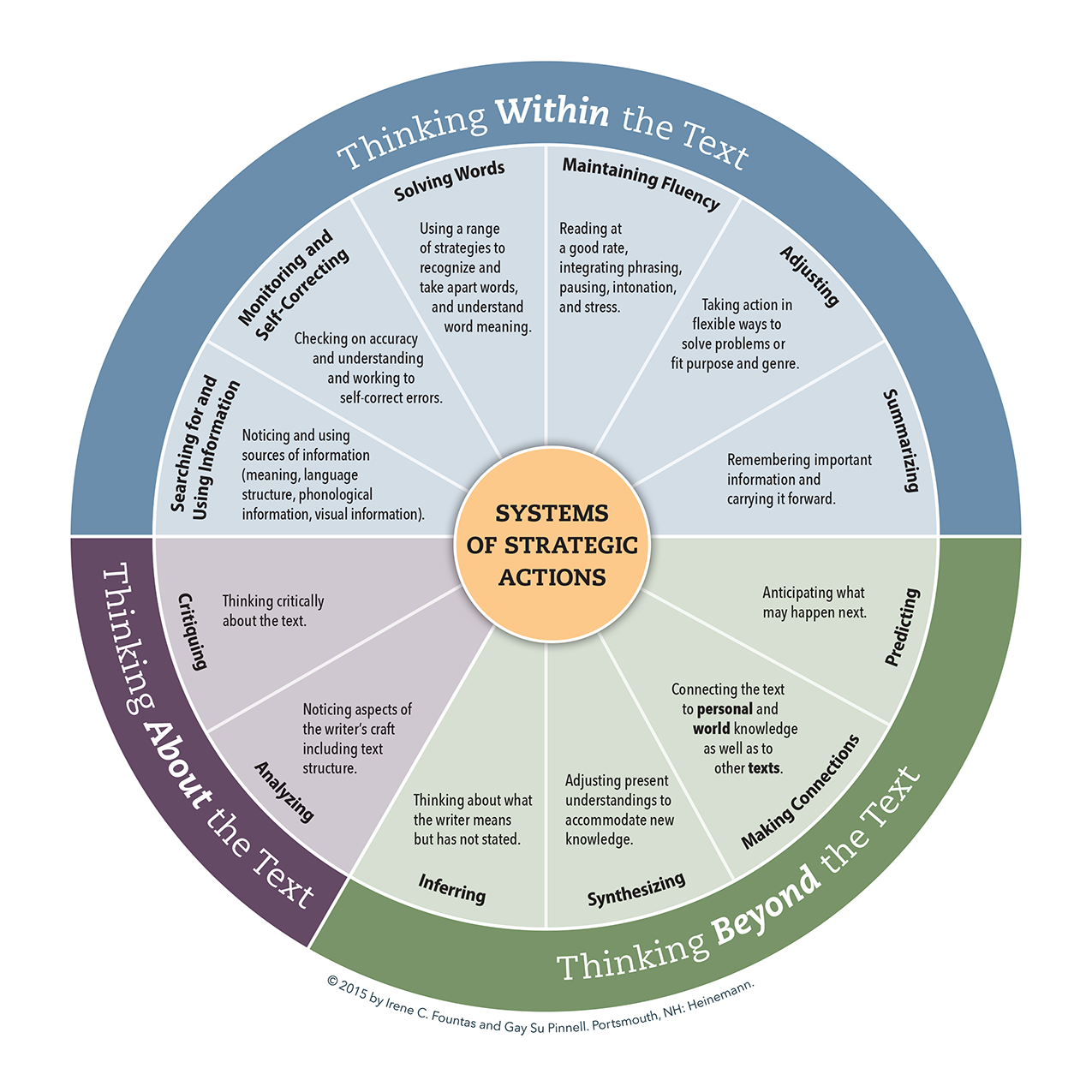This is the first in a series of blogs about The Fountas & Pinnell Literacy Continuum. In order to understand The Literacy Continuum it is essential to understand the Systems of Strategic Actions (SOSA). Read on to learn more.
This is the first in a series of blogs about The Fountas & Pinnell Literacy Continuum. In order to understand The Literacy Continuum it is essential to understand the Systems of Strategic Actions (SOSA). Read on to learn more.
What are Systems of Strategic Actions?
 Take a moment to look at the SOSA graphic above. Fountas and Pinnell developed this graphic to illustrate the highly complex thinking proficient readers do as they engage with text. The authors use twelve categories that they call “Systems of Strategic Actions” (SOSA), to describe the problem-solving the brain must do to create meaning during reading. Whether you’re a beginning reader or a seasoned reader, all twelve systems are in use. While beginning readers may need to slow down to deliberately search for information or solve words, proficient readers integrate these twelve systems rapidly, simultaneously, and in a smooth and orchestrated way.
Take a moment to look at the SOSA graphic above. Fountas and Pinnell developed this graphic to illustrate the highly complex thinking proficient readers do as they engage with text. The authors use twelve categories that they call “Systems of Strategic Actions” (SOSA), to describe the problem-solving the brain must do to create meaning during reading. Whether you’re a beginning reader or a seasoned reader, all twelve systems are in use. While beginning readers may need to slow down to deliberately search for information or solve words, proficient readers integrate these twelve systems rapidly, simultaneously, and in a smooth and orchestrated way.
The authors categorize the SOSA into three ways of thinking:
1. Thinking Within the Text
Thinking within the text refers to searching for and using information, monitoring and self-correcting, solving words, maintaining fluency, adjusting, and summarizing. By engaging in these strategic actions, readers acquire a literal understanding that they will use to expand their understanding of the texts as they think beyond and about the text.
2. Thinking Beyond the Text
When readers think beyond the text, they bring their prior knowledge and understanding of how the world works to the text in order to:
- make informed predictions
- make meaningful connections between the content of the text and their own life, other texts, and the world around them
- synthesize information and shift their thinking to incorporate new understandings
- infer what the author means but does not explicitly state.
Readers link their literal understandings of the text to their own experiences in order to construct an understanding of the deeper messages of the text.
3. Thinking About the Text
When readers think about the text, they are required to recognize the text as an object. Readers notice and analyze the crafting decisions that the writer made when writing the text. They critique these decisions by determining how effective the choices were in achieving the purpose. Thinking about the text enables the reader to learn more about how texts are structured and crafted by writers.
Behaviors to Notice, Teach for, and Support
Because these strategic actions happen inside of each reader’s head, they are not directly observable. We can only hypothesize about the ways in which each reader is becoming increasingly proficient by noticing behavioral evidence of these systems of strategic actions at work.
Ways to observe evidence of the processing systems at work:
- Evidence of within the text thinking can be collected by observing oral reading, with the exception of summarizing. Coding, scoring, and analyzing running or reading records allows teachers to notice how each reader problem solve their way across a text.
- Behavioral evidence of beyond the text and about the text thinking and summarizing is observable through analyzing students talking and writing.
Through carefully observing each student’s oral reading, their talk about text, and their writing about reading, the SOSA wheel comes to life.
Moving Towards Proficiency Together
When Fountas and Pinnell created the wheel graphic with its three color-coded “ways of thinking,” and named the twelve Systems of Strategic Actions, their goal was to help teachers conceptualize the thousands of simultaneous actions the brain engages in as we read. Understanding these twelve interconnected Systems of Strategic Actions supports teachers in developing:
- a shared theory of a complex in-the-head reading processing system
- a shared vocabulary for discussing their observations of readers and their teaching goals.
When teachers in a school system make instructional decisions based on a shared theory of reading, they are able to provide students with text opportunities and responsive teaching across the grades so that readers move along a coherent path to proficiency.
~The Fountas & Pinnell Literacy™ Team
Read the rest of our series on The Literacy Continuum:
How Does The Literacy Continuum Support Teachers of Reading?
Who Can Benefit from The Literacy Continuum?
6 Suggestions for Getting Started with The Literacy Continuum
*This blog was originally published on October 13, 2016.
For more collaborative conversation, join the Fountas & Pinnell Literacy™ Facebook Learning Group.


